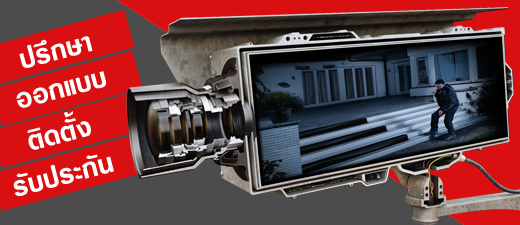หน้าแรก >> CCTV Surveillance
Video’s Critical Role in the Security Plan
1.2 THE ROLE OF VIDEO IN ASSET PROTECTION
Video provides multiple functions in the overall security plan. Itprovides the function of asset protection by moni toring location of assets and activity in their location. It is used to detect unwanted entry into a facility beginning at a perimeter location and following an unauthorized per son throughout a facility. Figure 1-1 shows a typical single site video system using either legacy analog or digital, or a combination of both technologies.
In a perimeter protection role, video is used with intrusion-detection alarm devices as well as video motion detection to alert the guard at the security console that an intrusion has occurred. If an intrusion occurs, multi ple CCTV cameras located throughout the facility follow the intruder so that there is a proper response by guard personnel or designated employees. Management must determine whether specific guard reaction is required and what the response will be.
Video monitoring allows the guard to be more effec tive, but it also improves security by permitting the camera scene to be transmitted to other control centers or per sonnel. The video image can be documented with a VCR, DVR, and/or printed out on a hard copy video printer.
The video system for the multiple site application is best implemented using a combination of analog/digital or an all-digital solution (Figure 1-2).
Local site installations already using analog video cam eras, monitors, etc. can be retained and integrated with new digital Internet Protocal (IP) cameras, local area net works (lANs), intranets, and the Internet to facilitate remote site video monitoring. The digital transmission network provides two-way communications of audio and controls and excellent video image transmission to remote sites. The digital signals can be encrypted to prevent eavesdropping by unauthorized outside personnel. Using a digital signal backbone allows adding additional cam eras to the network or changing their configuration in the system.

In the relatively short history of CCIV and video there have been great innovations in the permanent record ing of video images. These new technologies have been brought about by the consumer demand for video cam corders, the television broadcast industry, and government requirements for military and aerospace hardware and software. One result of these requirements was the devel opment of the VCR and DVR. The ability to record video images provided the video security industry with a new dimension, i.e. going beyond real-time camera surveil lance. The availability of VCR and DVR technology result ing from the consumer market has made possible the excellent time-lapse VCRs and large storage PC-based DVR systems. These technologies provide permanent documen tation of the video images in analog (magnetic tape) and digital (solid state and bard disk drive) storage media. The use of time-lapse recorders, computer hard disks and video printers give management the tools to present hard evidence for criminal prosecution. This ability to provide a permanent record of evidence is of prime importance to personnel responsible for providing security.
Prior to the mid-1990s the CCTV security industry pri marily used monochrome solid-state cameras. In the 1990s the widespread use of color camcorders in the video con sumer market accelerated the availability of these reliable, stable, long-life cameras for the security industry. While monochrome cameras are still specified in low light level (l.l.l...) and nighttime security applications, color is now the norm in most security applications. The increased sensitivity and resolution of color cameras and the signif icant decrease in cost of color cameras have resulted in their widespread use. Many monochrome cameras being used for LIL applications are being augmented with active infrared (IR) illuminators. Also coming into use is a new generation of passive monochrome thermal IR imaging cameras that detect the differences in temperature of objects in the scene, compared to the scene background. These cameras operate in total darkness. There has also been an explosion in the use of covert video sUIVeillance through the use of small, inexpensive color cameras.
The development of smaller solid-state cameras has resulted in a decrease in the size of ancillary video equip ment. Camera lenses, dome cameras, housings, pan/tilt mechanisms, and brackets are smaller in size and weight resulting in lower costs and providing more aesthetic installations. The small cameras and lenses satisfy covert video applications and are easy to conceal.

The potential importance of color in surveillance applications can be illustrated very clearly: tum off the color on a television monitor to make it a monochrome scene. It is obvious how much information is lost when the col ors in the scene change to shades of gray. Objects that were easily identified in the color scene become difficult to identify in the monochrome scene. It is much easier to pick out a person with a red shirt in the color image than in a monochrome image.
The security industry has long recognized the value of color to enhance personnel and article identification in video surveillance and access control. One reason why we can identify subjects more easily in color is that we are used to seeing color, both in the real world and on our 'IV at home. When we see a monochrome scene we have to make an additional effort to recognize certain information (besides the actual missing colors) thereby decreasing the intelligence available. Color provides more accurate identification of personnel and objects and leads to a higher degree of apprehension and conviction of criminals.
1.2.1 Video as Part of the Emergency and Disaster Plan
Every organization regardless of size should have an emer gency and disaster control plan that includes video as a critical component. Depending on the organization an anti-terrorist plan should take highest priority. Part of the plan should be a procedure for succession of personnel in the event one or more members of top management are unavailable when disaster strikes. In large organiza tions the plan should include the designation of alternate headquarters if possible, a safe document-storage facility, and remote (off-site if possible) video operations capabil ity. The plan must provide for medical aid and assure the welfare of all employees in the organization. Using video as a source of information, there should be a method to alert employees in the event of a dangerous condition and a plan to provide for quick police and emergency response. There should be an emergency shutdown plan and restoration procedures with designated employees act ing as leaders. There should be CCTV cameras stationed along evacuation routes and instructions for practice tests. The evacuation plan should be prepared in advance and tested.
A logical and effective disaster control plan should do the following:
- • Define emergencies and disasters that could occur as they relate to the particular organization.
- • Establish an organization and specific tasks with personnel designated to carry out the plan immediately before, during, and immediately following a disaster.
- • Establish a method for utilizing the organization's resources, in particular video, to analyze the disaster situation and bring to bear all available resources.
- • Recognize a plan to change from normal operations into and out of the disaster emergency mode as soon as possible.
Video plays a very important role in any emergency, disaster and anti-terrorist plan:
- • Video helps protect human life by enabling security or safety officials to see remote locations and view first hand what is happening, where it is happening, what is most critical, and what areas must be attended to first
- • Aids in minimizing personal injury by permitting "remote eyes" to get to those people who require imme diate attention, or to send personnel to the area being hit hardest to remove them from the area, or to bring in equipment to protect them.
- • Video reduces the exposure of physical assets to oncom ing disaster, such as fire or flood, and prevents or at least assesses document removal (of assets) by intruders or any unauthorized personnel.
- • Video documents the equipment and assets that were in place prior to the disaster, recording them on VCR, DVR or storage on an enterprise network to be compared to the remaining assets after the disaster has occurred. It also documents personnel and their activities before, during, and after an incident.
- • Probably more so than any other part of a security system, video will aid management and the security force in minimizing any disaster or emergency. It is useful in restoring an organization to normal operation by deter mining that no additional emergencies are in progress and that procedures and traffic flow are normal in those restored areas.
1.2.1.1 Protecting Life and Minimizing Injury
Through the intelligence gathered from the video sys tem, security and disaster control personnel should move all personnel to places of safety and shelter. Personnel assigned to disaster control and remaining in a threatened area should be protected by using video to monitor their safety, and the access and egress at these locations. By such monitoring, advance notice is available to provide a means of support and assistance for those persons if injured, and personnel that must be rescued or relieved.
1.2.1.2 Reducing Exposure of Physical Assets and Optimizing Loss Control
Assets should be stored or secured properly before an emer gency sothat theywillbe lessvulnerable to theft orloss.Video is an important tool for continually monitoring safe areas during and after a disaster to ensure that the material is not removed. Inan emergency ordisaster, thewell-documented plan will call for specific personnel to locate highly valued assets, secure them, and evacuate personnel.
1.2.1.3 Restoring Normal Operations Quickly
After an emergency situation has been brought under control, security personnel can monitor and maintain the security of assets and help determine that employees are safe and have returned to their normal work routine.
1.2.1.4 Documenting an Emergency
For purposes of: (I) future planning, (2) liability and insurance, and (3) evaluation by management and secu rity personnel, video coverage of critical areas and oper ations during an emergency is an excellent tool and can reduce financial losses significantly. Video recordings of assets lost or stolen or personnel injured or killed can sup port a company's claim that it was not negligent and that it initiated a prudent emergency and disaster plan prior to the event. Although video can provide crucial documen tation of an event, it should be supplemented with high resolution photographs of specific instances or events.
If perimeter fences or walls were destroyed or dam aged in a disaster, video can help prevent and document intrusion or looting by employees, spectators, or other outsiders.
1.2.1.5 Emergency Shutdown and Restoration
In the overall disaster plan, shutting down equipment such as machinery, utilities, processes, and so on, must be considered. If furnaces, gas generators, electrical power equipment, boilers, high-pressure air or oil systems, chem ical equipment, or rapidly rotating machinery could cause damage if left unattended they should be shut down as soon as possible. Again, video surveillance can be crucial to determine if the equipment has been shut down prop erly, ifpersonnel must enter the area to do so, or if it must be shut down by other means.
1.2.1.6 Testing the Plan
While a good emergency plan is essential, it should not be tested for the first time in an actual disaster situation. Deficiencies are always discovered during testing. Also, a test seiVes to train the personnel who will carry out the plan if necessary. Video can help evaluate the plan to identify shortcomings and show personnel what they did right and wrong. Through such peer review a practical and efficient plan can be put in place to minimize losses to the organization.
1.2.1.7 Standby Power and Communications
During any emergency or disaster, primary power and communications between locations will probably be dis rupted. Therefore, a standby power-generation system should be provided for emergency monitoring and response. This standby power comprised of a backup gas powered generator or an uninterruptible power supply with DC batteries to extend backup operation time will keep emergency lighting, communications, and strategic video equipment online as needed. Most installations use a power sensing device that monitors the normal supply of power at various locations. When the device senses that power has been lost, the various backup equipments auto matically switch to the emergency power source.
A prudent security plan anticipating an emergency will
include a means to power vital, audio, video, and other sen sor equipment to ensure its operation during the event. Since emergency video and audio communications must be maintained over remote distances, alternative commu nication pathways should be supplied in the form of either auxiliary hard-wired cable (copper wire or fiber optics) or a wireless (RF, microwave, infrared) transmission system. It is usually practical to provide abackup path toonly the critical cameras, not all of them. The standby generator supply ing power to the video, safety, and emergency equipment must be sized properly. For equipment that normally oper ates on 120 volt AC, inverters are used to convert the low voltage from the backup DC batteries (typically 12 or 24 volts DC) to the required 120 volts AC (or 230 volts AC).
1.2.2 Security Investigations
Security investigators have used video very successfully with respect to safeguarding company assets and preventing theft, negligence, outside intrusion, and so on. By using small, low-cost, covert CCIV (hidden camera and lens), it is easy to positively identify a person or to document an event without being noticed. Better video image quality, smaller lenses and cameras, wireless video transmission, and easier installation and removal of such equipment have led to this high success. Many lenses and cameras that can be hidden in rooms, hallways, or stationary objects are available today. Equipment to provide such sUIVeillance is available for indoor or outdoor locations in bright sunlight or in no light (IR-illuminated or thermal cameras).
1.2.3 Safety
Closed circuit television equipment is installed not always for security reasons alone but also for safety purposes as well. Security personnel can be alerted to unsafe practices or accidents that require immediate attention. An attentive guard can use CCTV cameras distributed throughout a facility in stairwells, loading docks, around machinery, etc. to obseiVe and immediately document any safety violations or incidents.
1.2.4 The Role of the Guard
Security guards are employed to protect plant assets and personnel. Security and corporate management are aware that guards are only one element of an organization's complete security plan. As such, the cost to implement the guard force and its ability to protect assets and personnel are analyzed in relation to the costs and roles of other technological security solutions. In this respect video has much to contribute: increased security for relatively low capital investment and low operating cost, as compared with a guard. Guards using video can increase the security coverage or protection of a facility. Alternatively, installing new CCTV equipment enables guards to monitor remote sites, allowing guard count and security costs to be reduced significantly.
1.2.5 Employee Training and Education
Video can be used as a powerful training tool. It is used widely in education and the training of security personnel because it can demonstrate lessons and examples vividly to the trainee. In this post-9/11 era, security personnel should receive professional training by all means including real video footage. Video is an important tool for the secu rity trainer. Example procedures of all types can be shown conveniently in a short time period, and with instructions given during the presentation. Videotaped real-life situa tions (not simulations or performances) can demonstrate the consequences of mis-applied procedures and the ben efits of proper planning and execution by trained and knowledgeable personnel.
Every organization can supplement live training with either professional training videos or actual scenes from their own video system, demonstrating good and poor practices as well as proper guard reaction in real cases of intrusion, unacceptable employee behavior, and so on. Such internal video systems can also be used in training exercises: trainees may take part in videotaped simulations, which are later critiqued by their supervisor. Trainees can then observe their own actions to find ways to improve and become more effective. Finally, such internal video systems are very important tools during rehearsals or tests of an emergency or disaster plan. After the run-through, all team members can monitor their own reactions, and managers or other professionals can critique them.


















